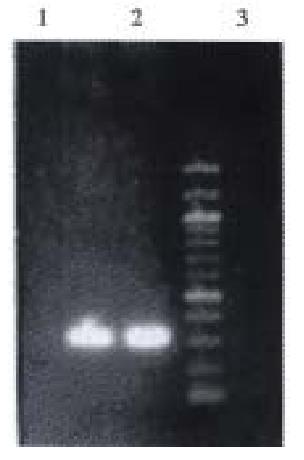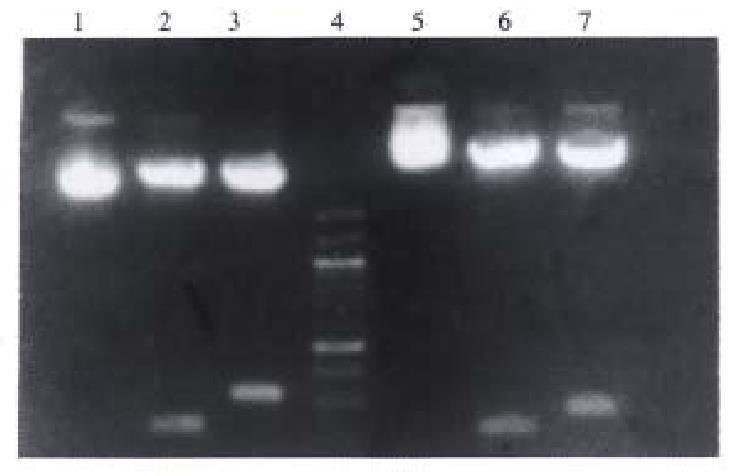Published online Jun 15, 1999. doi: 10.3748/wjg.v5.i3.241
Revised: March 1, 1999
Accepted: March 20, 1999
Published online: June 15, 1999
AIM: To obtain human and murine cDNAs encoding IFN-γ inducible protein 10 (IP-10) and cytokine responsive gene-2 (Crg-2).
METHODS: The encoding genes of IP-10 and Crg-2 were amplified by RT-PCR from cultured human fibroblast cells and Balb/c mouse liver treated by IFN-γ and TNF-α , respectively, and cloned into plasmids of pUC19 and pGEM3Zf(+).
RESULTS: The nucleotide sequences of the amplified DNA were confirmed by endonucleases digestion and sequencing.
CONCLUSION: Recombinant IP-10/crg-2 gene clones with 306 bp and 314 bp inserts were established for further research on biological activities and ligands of hIP-10/mCrg-2
- Citation: Liu ZG, Yang JH, An HZ, Wang HY, He FT, Han ZY, Han Y, Wu HP, Xiao B, Fan DM. Cloning and identification of an angiostatic molecule IP-10/crg-2. World J Gastroenterol 1999; 5(3): 241-244
- URL: https://www.wjgnet.com/1007-9327/full/v5/i3/241.htm
- DOI: https://dx.doi.org/10.3748/wjg.v5.i3.241
Angiogenesis plays an important role in tumorigenesis and metastasis, and gene therapy targeting vasculature of neoplasms has become a hot topic[1]. Many new molecules, including endostatin and angiostatin, were discovered with significant inhibitory effect on neovascularization of tumor. Besides these molecules, some ‘old’ cytokines were also found to possess the bioactivity of inhibiting angiogenesis, including IP-10/Crg-2[2]. Human IP-10 belongs to a superfamily called chemokines and Crg-2 is its murine analogue. As a member of chemokines, IP-10/Crg-2 was primarily characterized as a proinflamm atic molecule. However, recent findings showed that IP-10/Crg-2 had a powerful inhibitioy effect in neovascularization of tumor, and tumor regression induced by IL-12 was closely related with high level of IP-10 expression and subsequent vasculature destruction[3]. However, little has been known about its properties, especially the mechanisms of its inhibitory effect on endothelium, since the receptor of IP-10/Crg-2, CXCR3, was predominantly distributed in activated T cells, but not in endothelial cells[4]. To further clarify the bioactivity of IP-10/Crg-2 and explore its potential application in gene therapy against angiogenesis, we amplified the gene sequence encoding IP-10 and Crg-2 by RT-PCR from primary human fibroblast cells and mouse liver, and cloned them into pUC19 and pGEM3Zf(+) vector, respectively.
Recombinant human IFN-γ was purchased from Bonding Co., Beijing. Recombinant TNF-α was kindly provided by Genetic Diagnosis Institute of our University. Endonucleases, T4 ligase and reverse transcriptase were purchased from Gibco BRL. Taq DNA polymerase was obtained from Perkin Elmer. 100 bp PCR marker was purchased from New England Biolabs. The kit for purification of plasmids and PCR products were obtained from Promega. Primers were synthesized by the Shanghai Bioengineering Center of Chinese Academy of Sciences. Host bacterial cell line DH5α, cloning vector pUC19 and pGEM3Zf(+) were stored in our lab.
Template preparation of human and mouse cDNA Human primary fib roblast cell was obtained by cultured surgically resected specimens of normal adult. 4 h before RNA extraction, human IFN-γ was added to reach a final concentration of 1 × 106 U/L for cell culture and Balb/c mice was individually injected with TNF-α 5 × 106 U. The total RNAs were then purified from fibroblast cells and mouse liver respectively by the method of guanidium/phenol, and reverse-transcripted to cDNA according to literature[5].
PCR amplification of IP-10 and Crg-2 encoding sequence Primers were designed according to the sequence of IP-10/crg-2. For human IP10, endonuclease sites were introduced: 5’ primer GGGCGCTAGC (Nhe I)CATATG(Nde I) AATCAAACTGCGATTCTGATT, 3’ primer AAGCTT( Hind III) GGTACC(Kpn I) TTAAGGAGATCTTTTAGACATTTCC. For murine crg-2, no endonucleases were introduced: 5’ primer ACCATGAACCCAAGTGCTGC; 3’ primer GCTTCACTCCAGTTAAGGAG. PCR cycle parame ters: 94 °C 45 s, 60 °C 45 s, 72 °C 45 s, 30 cycles in all. PCR reaction mixture consi sts of cDNA template (human or murine origin) 2 µL, 25 mmol/L MgCl2 8 µL, 10XPCR buffer 10 µL, 10 mmol/L dNTPs 4 µL, Taq DNA polymerase 2 µL, 50 µmol/L upstream and downstream primers 2 µL each, and distilled water was supp lement to 100 µL.
Construction of human IP-10 recombinant plasmid PCR amplification product was digested by endonucleases Nhe I and Kpn I, meanwhile pUC19 was cut by Xba I and Kpn I. After purification by agarose electrophoresis, these two fragments were ligated by cohesive ends and then the recombinant plasmid was introduced into E. coli line DH5 α. Clones were picked randomly by blue/white screening, and identified by endonucleases dige stion of Xba I/EcoR I and Hind III/Bgl II.
Construction of murine crg-2 recombinant plasmid Murine crg-2 recombinant plasmid was constructed by T/A cloning according to literature[6]. Five μg pGEM3Zf(+) was digested by Sma I. After purification by electrophoresis, 10 µL 10 × PCR buffer, 1 µL 100 mmol/L dTTP, 1 µL Taq DNA polymerase and distilled water were added to make a final volume of 100 µL and incubated at 75 °C for 2 h. The PCR product was ligated with vector and the recombinant was transformed into DH5α, clones were selected by blue/white screening, minipreps were extracted and the right insert was confirmed by endonuclease digestion with BamH I or Hin d III.
Sequence analysis DNA sequence analyses were conducted in the Central Lab of our university with automatic DNA analyzer (PE373-A, USA) according to the methods of Sanger.
PCR reactions were carried out using the obtained cDNAs of human fibroblast and murine liver treated by IFN- γ or TNF-α as the templates. Electrophoresis of PCR products indicated that fragments of about 300 bp were amplified in each of the reaction mixture, which were consistent with our expectation of 322 bp and 314 bp(Figure 1).
For recombinant constrution of human IP-10, purified PCR product was ligated with endonucleases-digested pUC19, and the recombinant was transformed into E.Coli line DH5α. White clones were picked and confirmed by dual endonucleases digestion with Xba I/EcoR I and Hin d III/Bgl II. Electrophoresis of 20 g/L-showed that fragments of about 237 bp and 318 bp were released respectively. This clone was identified as positive and named pUC19/h-IP-10 (Figure 2, lane 1-3). For vector construction of crg-2, the amplified fragment was ligated directly with pGEM3Zf(+) T vector, and recombinants were analyzed by single endonuclease digestion with Bam H I orHin d III. Electrophoresis of 20 g/L showed that a fragment of 251 bp or 204 bp was released the positive clones were named pGEM3Zf(+)/crg-2 (Figure 2, lane 5-7).
Minipreps of pUC19/IP-10 and pGEM3Zf(+)/crg-2 were prepared according to the manual of Promega Wizard Minipreps kit. Samples were analyzed with automatic sequence analyzer. Sequencing results showed that the 306 bp and 314 bp inserts were completely identical with reported sequences of IP-10[7] and crg-2[8], flanked by introduced endonuclease sites or added single T (Figure 3).
The growth of tumor is dependent on the vasculature for nutrition and oxygen. Destruction of established vasculature will lead tumor cells to necrosis or apoptosis, that is the main idea of angiostatic therapy. Tumor cells are highly heterogenic and multiple drug resistance (MDR) is very likely to be induced. But its endothelium, is more stable and susceptible to treatment and causes little[9] MDR. In normal adult, endothelium remains in dormant status except for wound-healing and menstruation. So inhibiting the process of active angiogenesis of tumor will eventually selectively cure the neoplasms and its metastasis without induction of MDR.
IP-10 was initially identified in 1985 as a member of CXC subfamily in chemokine superfamily[7]. The family of chemokines is characterized by 4 highly conservative cysteines at the N terminus of protein. Most chemokines are basic heparin binding protein possessing the activity of chemotaxis, which play important roles in inflammation and wound healing. According the different structures, gene location and bioactivities, this family can be divided into 2 subfamilies, CC and CXC subfamily. The first 2 cysteines of CC subfamily are adjacent with each other, while in CXC subfamily the cysteines were separated by a single random residue. IP-10/Crg-2 is a secreted protein consisting of 98 amino acids, of which the first 21 amino acids represent a signal peptide, with a Mr of 6000-7000 for mature form. Its receptor CXCR3 was successfully cloned in 1996[4].The receptor belonging to seven transmembrane G-protein coupled receptors expressed primarily on activated T cell. The best-described bioactivities of IP-10/Crg-2 include angiogenesis inhibition, bone marrow hemopoeitic stem cell inhibition, chemotaxis for activated T cell and monocyte-macrophage[10]. Among them, the most attracting property is the effect on vasculature, especially after it is found to be the downstream molecule for IFN-γ or IL-12 to induce the regression of tumor[3,11]. But most researches are focused on its induction or its effects on various kinds of tissues and cells, and are far from the insight of its biological activity and signal transduction process.
We amplified the complete cDNA sequences of IP-10/Crg-2. The target gene clones were established and confirmed by endonuclease digestion and sequence analysis. This will help us further clarify the bioactivity of IP-10/Crg-2 and the downstream mechanism after receptor binding.
Edited by Jing-Yun Ma
| 1. | Folkman J. Antiangiogenic gene therapy. Proc Natl Acad Sci USA. 1998;95:9064-9066. [RCA] [PubMed] [DOI] [Full Text] [Cited by in Crossref: 141] [Cited by in RCA: 143] [Article Influence: 5.3] [Reference Citation Analysis (0)] |
| 2. | Keane MP, Arenberg DA, Lynch JP, Whyte RI, Iannettoni MD, Burdick MD, Wilke CA, Morris SB, Glass MC, DiGiovine B. The CXC chemokines, IL-8 and IP-10, regulate angiogenic activity in idiopathic pulmonary fibrosis. J Immunol. 1997;159:1437-1443. [PubMed] |
| 3. | Sgadari C, Angiolillo AL, Tosato G. Inhibition of angiogenesis by interleukin-12 is mediated by the interferon-inducible protein 10. Blood. 1996;87:3877-3882. [PubMed] |
| 4. | Loetscher M, Gerber B, Loetscher P, Jones SA, Piali L, Clark-Lewis I, Baggiolini M, Moser B. Chemokine receptor specific for IP10 and mig: structure, function, and expression in activated T-lymphocytes. J Exp Med. 1996;184:963-969. [RCA] [PubMed] [DOI] [Full Text] [Full Text (PDF)] [Cited by in Crossref: 921] [Cited by in RCA: 953] [Article Influence: 32.9] [Reference Citation Analysis (0)] |
| 5. | Sambrook J, Fritsch EF, Maniatis T. Molecular cloning: a laboratory manual. 2nd ed. New York: Cold Spring Harbor Laboratory Press. 1989;60-87. |
| 6. | Borovkov AY, Rivkin MI. XcmI-containing vector for direct cloning of PCR products. Biotechniques. 1997;22:812-814. [PubMed] |
| 7. | Luster AD, Unkeless JC, Ravetch JV. Gamma-interferon transcriptionally regulates an early-response gene containing homology to platelet proteins. Nature. 1985;315:672-676. [RCA] [PubMed] [DOI] [Full Text] [Cited by in Crossref: 691] [Cited by in RCA: 785] [Article Influence: 19.6] [Reference Citation Analysis (0)] |
| 8. | Vanguri P, Farber JM. Identification of CRG-2. An interferon-inducible mRNA predicted to encode a murine monokine. J Biol Chem. 1990;265:15049-15057. [PubMed] |
| 9. | Boehm T, Folkman J, Browder T, O'Reilly MS. Antiangiogenic therapy of experimental cancer does not induce acquired drug resistance. Nature. 1997;390:404-407. [RCA] [PubMed] [DOI] [Full Text] [Cited by in Crossref: 88] [Cited by in RCA: 88] [Article Influence: 3.1] [Reference Citation Analysis (0)] |
| 10. | Baggiolini M, Dewald B, Moser B. Human chemokines: an update. Annu Rev Immunol. 1997;15:675-705. [RCA] [PubMed] [DOI] [Full Text] [Cited by in Crossref: 1634] [Cited by in RCA: 1633] [Article Influence: 58.3] [Reference Citation Analysis (0)] |
| 11. | Yu WG, Ogawa M, Mu J, Umehara K, Tsujimura T, Fujiwara H, Hamaoka T. IL-12-induced tumor regression correlates with in situ activity of IFN-gamma produced by tumor-infiltrating cells and its secondary induction of anti-tumor pathways. J Leukoc Biol. 1997;62:450-457. [PubMed] |











